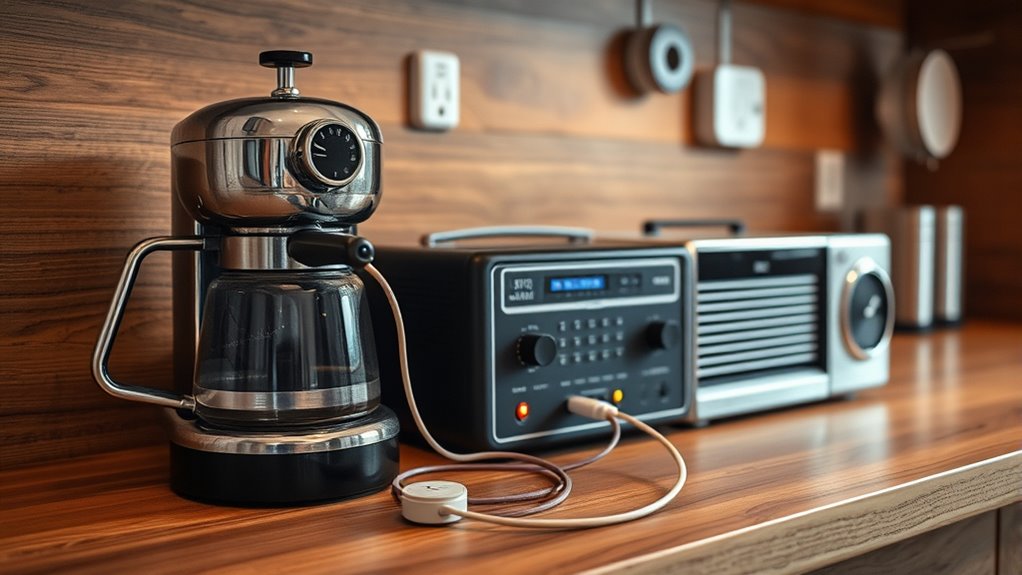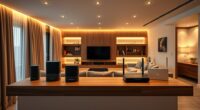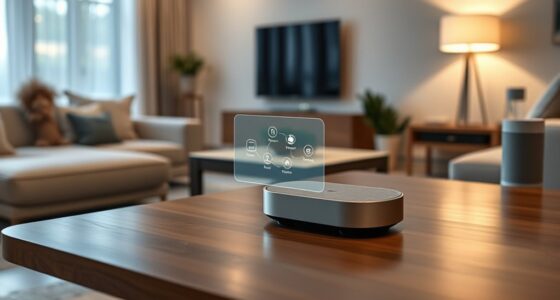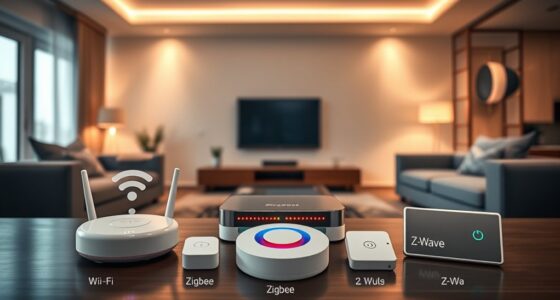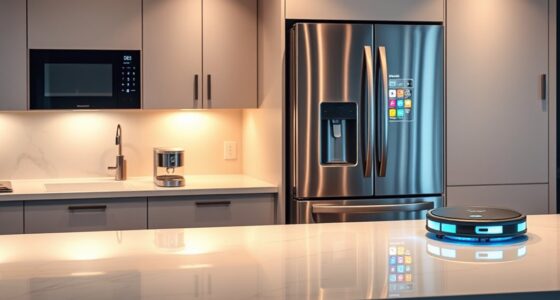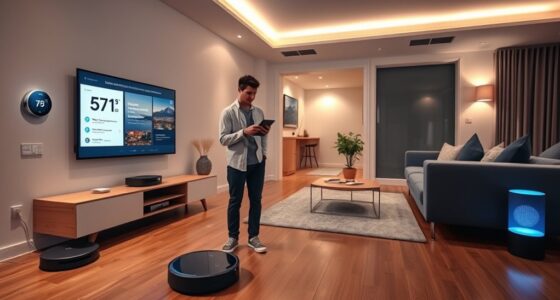To retrofit old devices for your smart home, start by evaluating their compatibility with your chosen hub or platform, and consider adding smart plugs or outlets to control traditional appliances remotely. Upgrade with Wi-Fi or Bluetooth modules if needed, and explore retrofit kits or conversion devices to enhance functionality. Set up voice control and secure your system with strong passwords and updates. For more detailed steps, discover how to optimize your retrofitting efforts effectively.
Key Takeaways
- Assess device compatibility and energy consumption to determine if retrofitting or replacement is more effective.
- Use smart kits or modules designed for existing fixtures to add remote control and scheduling features.
- Ensure proper installation, safety, and compatibility with your smart home hub and protocols (Zigbee, Z-Wave, Wi-Fi).
- Test connectivity and control functions thoroughly, updating firmware as needed for optimal performance.
- Implement security measures like encryption and strong passwords to protect your retrofitted devices and network.
Assessing Your Devices and Compatibility
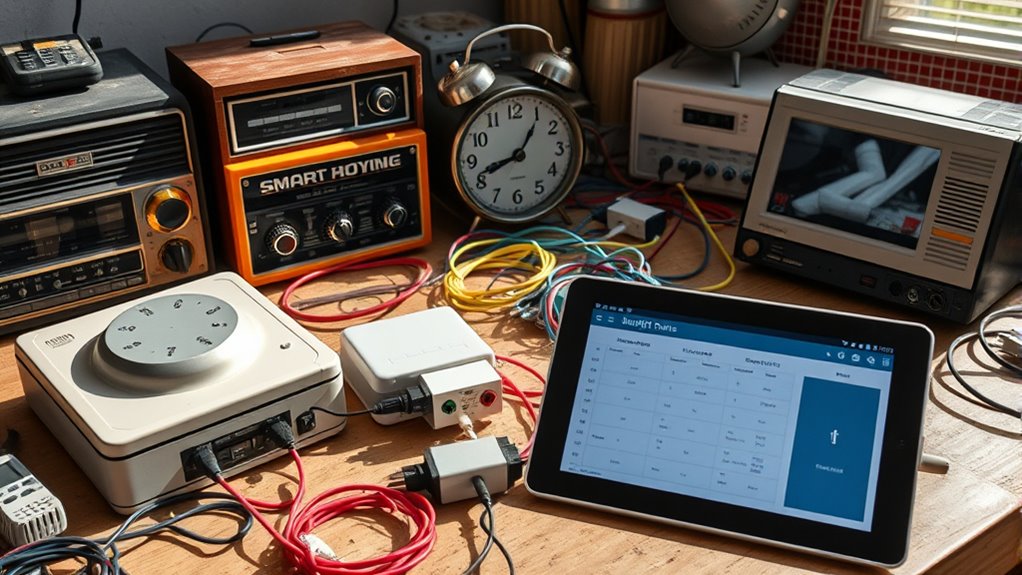
Before upgrading your devices, you need to assess their compatibility with smart home systems. Check whether your existing gadgets can connect to newer platforms or if you’ll need adapters or replacements. Consider their energy consumption; older devices often use more power, which can lead to higher bills and less efficient operation. Also, evaluate their device longevity—if a device is nearing the end of its lifespan, investing in a retrofit might not be cost-effective. Testing compatibility early helps you avoid unnecessary expenses and ensures a smooth integration process. By understanding how your current devices perform and their limitations, you set a solid foundation for a smarter, more efficient home. Additionally, assessing the device lifespan can prevent premature replacements and optimize your retrofit investments. Understanding the limitations of older devices can help you determine whether retrofitting is worthwhile or if replacement would be more effective. Taking this step saves time, money, and frustration later on. For example, some older devices may lack the necessary connectivity features to work seamlessly with modern smart home hubs, making upgrades or replacements necessary. Moreover, evaluating the compatibility with smart platforms ensures your devices can integrate smoothly without extensive modifications. Conducting this assessment can also help identify potential security vulnerabilities in outdated devices, which is crucial for maintaining a safe smart home environment.
Choosing the Right Smart Home Hub or Platform
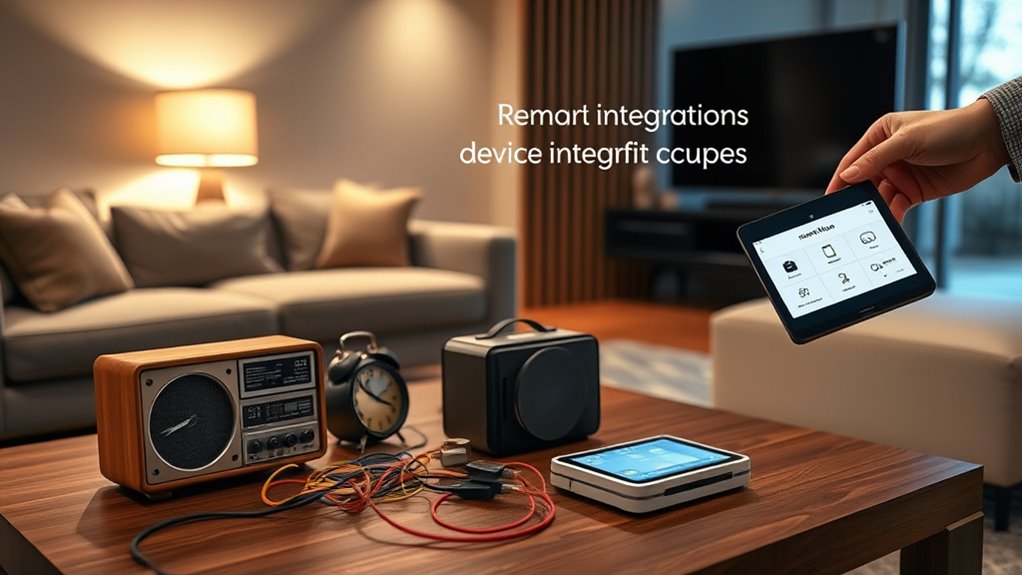
Selecting the right smart home hub or platform is essential to guarantee seamless integration and future expandability. You need a system that aligns with your device aesthetics and offers clear user education. Consider these factors:
Choosing a compatible, user-friendly smart home hub ensures seamless integration and future expansion.
- Compatibility with your existing devices and protocols (Zigbee, Z-Wave, Wi-Fi). Ensuring compatibility with your smart device protocols can prevent frustrating connectivity issues later. Additionally, verifying whether the platform supports interoperability with various brands can save you time and effort in the long run.
- User interface and ease of use, especially if you’re new to smart homes.
- Support for third-party integrations to expand your setup.
- Community and customer support for troubleshooting and user education.
- Incorporating meditation techniques into your routines can help reduce stress and improve overall well-being, making your smart home environment more conducive to relaxation.
Choosing a hub that matches your device aesthetics helps your setup look cohesive. Prioritize platforms that offer straightforward instructions and tutorials to minimize confusion. This ensures your retrofit project is smooth and future-proof.
Adding Smart Plugs and Outlets to Traditional Devices
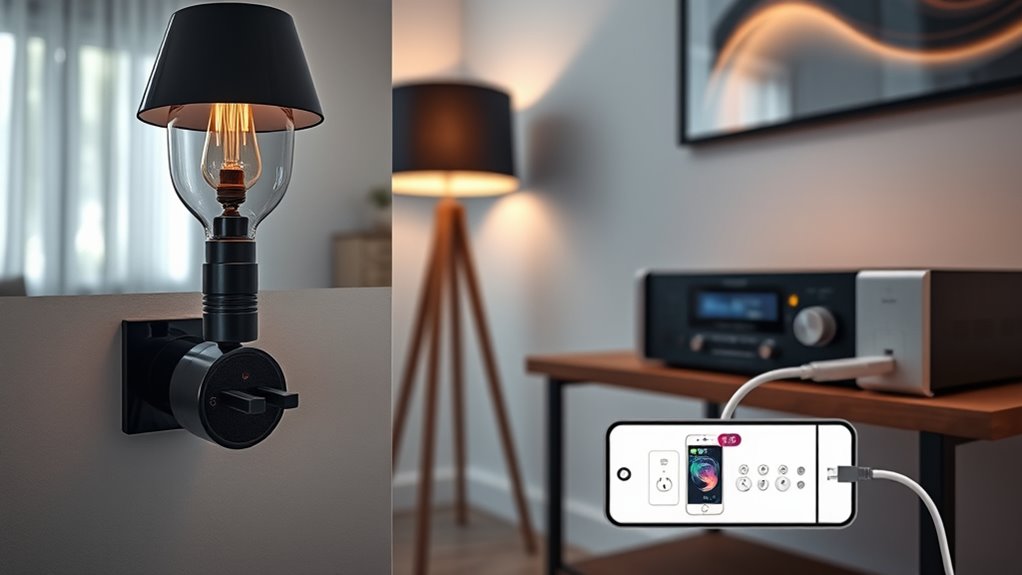
Adding smart plugs and outlets is one of the easiest ways to retrofit your traditional devices for a smarter home. They allow you to control vintage appliances remotely, making them more functional without altering their look. To guarantee aesthetic integration, choose sleek, unobtrusive models that blend seamlessly with your decor. You can automate lamps, fans, or old coffee makers, turning them on or off with a tap or voice command. Here’s an example setup:
| Device | Smart Plug Type | Aesthetic Fit |
|---|---|---|
| Vintage lamp | Compact, white | Discreet, blends with decor |
| Old fan | Slim, black | Minimal, unobtrusive |
| Retro coffee maker | Vintage-style plug | Maintains aesthetic charm |
| Classic radio | Hidden outlet | Preserves vintage look |
Additionally, integrating these devices can help monitor energy usage and contribute to a more sustainable home environment by reducing unnecessary power consumption. Incorporating energy-efficient smart home devices can further optimize your setup for savings and convenience.
Upgrading With Wi-Fi or Bluetooth Modules
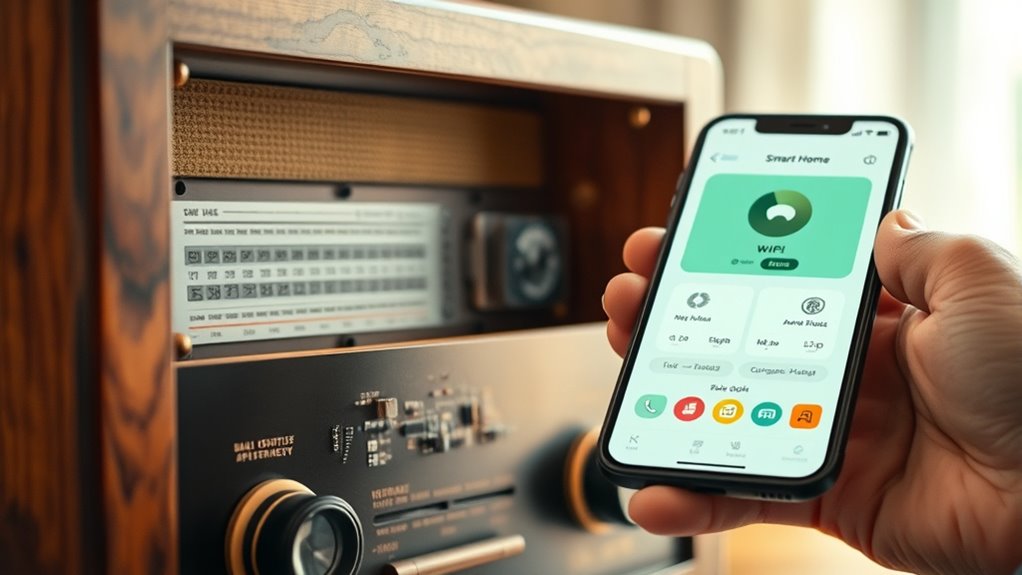
Upgrading your traditional devices with Wi-Fi or Bluetooth modules enables more advanced control options and seamless integration into your smart home. This approach leverages wireless protocols to communicate with your central hub or app. To guarantee smooth operation, you’ll need to:
- Select compatible wireless modules suited for your device.
- Update the device firmware to support new wireless protocols.
- Install the modules securely, following manufacturer instructions.
- Test connectivity and control functions through your smart home app.
- Ensuring proper wireless compatibility can prevent connection issues and enhance performance. Additionally, verifying the aesthetic appeal of the upgraded components can help maintain the overall style of your home decor. Checking the device specifications beforehand can also ensure compatibility and ease of installation. Proper security protocols should be implemented during setup to protect your network from potential vulnerabilities. These upgrades allow your devices to respond instantly and reliably. Keep in mind, updating device firmware is essential to optimize performance and security. By integrating Wi-Fi or Bluetooth modules, you transform old devices into smart-capable tools without replacing them entirely.
Utilizing Retrofits and Conversion Kits
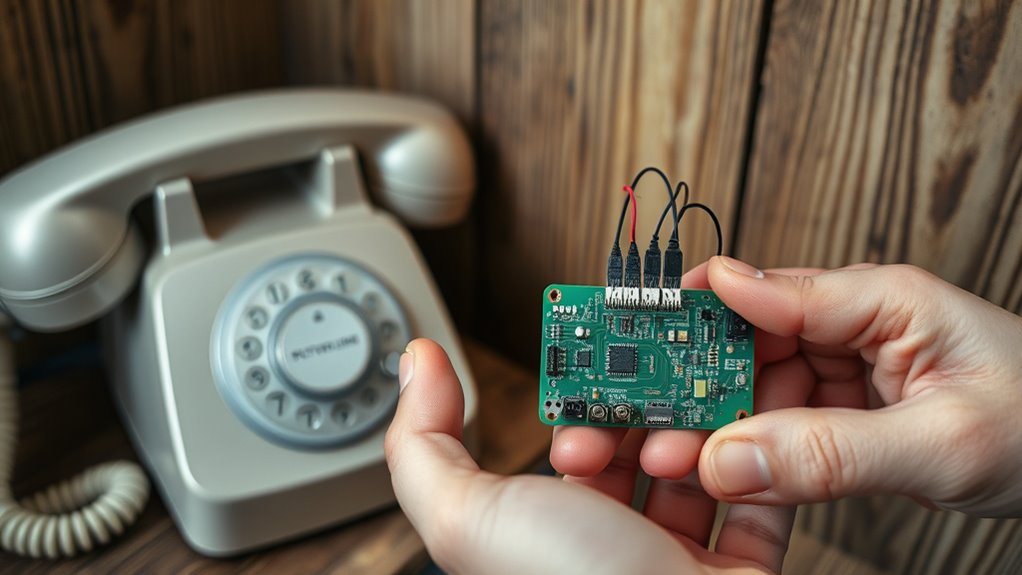
Utilizing retrofits and conversion kits offers a practical way to transform existing devices into smart-enabled tools without the need for complete replacements. With these kits, you can upgrade your lighting system to include smart lighting features, allowing you to control lights remotely or set schedules. They also enable energy monitoring, giving you insights into your energy consumption and helping you reduce waste. Many kits are designed for easy installation, often fitting into existing fixtures or switches. This approach saves money and time, making it accessible even if you’re not tech-savvy. Additionally, risk management is important when retrofitting devices to ensure compatibility and safety, especially when dealing with electrical components. Being aware of skin sensitivity and choosing compatible products can prevent issues during installation. Properly installation procedures are crucial to avoid damaging existing wiring or voiding warranties. Consulting professional electricians can help ensure the retrofit is performed safely and correctly. Moreover, understanding gym hours and scheduling workouts accordingly can inspire motivation and consistency in your fitness journey. By retrofitting your current devices, you extend their lifespan and seamlessly integrate them into your smart home ecosystem, improving convenience and efficiency without the hassle of full replacements.
Setting Up Voice Control Integration

To set up voice control, you’ll need to verify your old devices are compatible with your chosen voice assistant. Once compatibility is confirmed, you can configure your smart speaker to recognize and control these devices seamlessly. This process makes managing your smart home more intuitive and hands-free. Additionally, consulting pediatric sleep specialists can provide tailored advice for optimizing sleep environments and routines. Ensuring your devices are properly integrated with your ecosystem can enhance overall performance and user experience. Remember to check the device compatibility standards to ensure smooth operation with your voice control system.
Voice Assistant Compatibility
Have you ever wondered how to make your old devices respond to your voice commands? To enable voice assistant compatibility, you need to confirm your devices work with speech recognition technology. Start by choosing a compatible voice assistant platform, like Alexa or Google Assistant. Then, follow these steps:
- Connect your smart hub or bridge to your Wi-Fi network.
- Install the appropriate app and create an account.
- Enable the device skill or integration within the app.
- Use voice commands to test recognition and control.
Configuring Smart Speaker Integration
Once you’ve confirmed your devices are compatible with your chosen voice assistant, the next step is to configure your smart speaker for seamless integration. Start by opening the voice assistant app and browsing to the device pairing section. Follow the prompts to add your smart speaker and enable the voice command features. Make sure to connect your old devices by linking them through the app, ensuring they respond to voice commands. During setup, verify that each device appears correctly and responds to commands. Test the setup by giving simple voice commands, like “turn on the living room lamp” or “play music.” Proper device pairing guarantees smooth operation, so double-check connections if any device doesn’t respond. With this setup, your old devices become easily accessible through voice control.
Ensuring Security and Privacy for Your Smart Devices
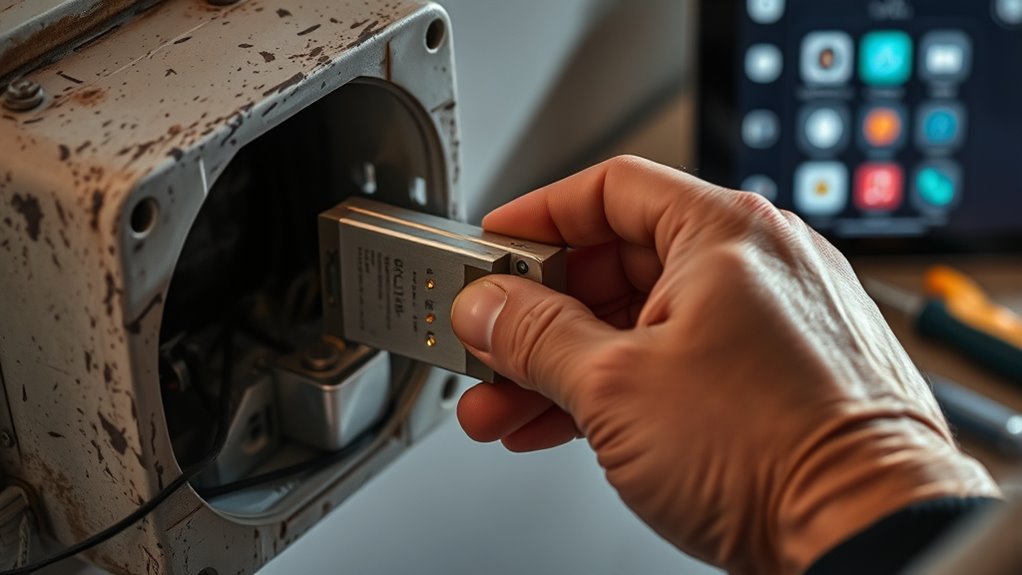
Ensuring the security and privacy of your smart devices is essential as they become more integrated into your daily life. To protect your data and user privacy, follow these steps:
- Enable data encryption on your devices and network to secure your information from hackers.
- Use strong, unique passwords for device accounts and change them regularly.
- Keep your firmware and software updated to patch security vulnerabilities.
- Limit access rights, granting permissions only to trusted users and devices.
Implementing these measures helps safeguard your smart home from unauthorized access. Prioritizing data encryption and user privacy guarantees your personal information remains confidential. Staying proactive in securing your devices minimizes risks and enhances your smart home’s overall security.
Troubleshooting Common Retrofit Challenges

When retrofitting old devices, you might encounter compatibility issues, power supply problems, or weak signals. These challenges can disrupt your smart home setup and cause frustration. Addressing these common hurdles promptly guarantees your devices work seamlessly together.
Compatibility Issues and Fixes
Compatibility issues are among the most common hurdles when retrofitting old devices for a smart home. Obsolete devices often lack support for modern protocols, making integration tricky. To fix this, try the following:
- Check if firmware updates are available; updating firmware can add compatibility.
- Use a universal hub or bridge that supports multiple protocols like Zigbee or Z-Wave.
- Consider replacing or upgrading obsolete devices with newer models that support smart home standards.
- Use third-party apps or custom firmware to enhance compatibility with your system.
Power Supply Troubleshooting
Power supply issues are a common obstacle when retrofitting old devices for a smart home, often causing devices to malfunction or not power on at all. To troubleshoot, check the power input to verify it’s compatible with the device’s requirements. Problems with voltage regulation can lead to inconsistent performance or failure to operate. Use a multimeter to verify that the power supply provides stable voltage levels. Sometimes, old power adapters can degrade over time, necessitating replacement. Consider this table for key checks:
| Issue | Solution | Notes |
|---|---|---|
| Insufficient power input | Upgrade power supply or adapter | Match voltage and current specs |
| Voltage fluctuations | Use voltage regulator or surge protector | Prevent damage from spikes |
| Faulty wiring | Inspect and replace damaged wiring | Ensure secure connections |
Connectivity and Signal Strength
Connectivity and signal strength often pose significant challenges when retrofitting old devices for a smart home, especially if they rely on wireless communication. Wireless interference and signal degradation can cause devices to disconnect or perform poorly. To troubleshoot these issues, consider:
- Reposition your router for better coverage, reducing dead zones.
- Remove obstacles like thick walls or metal objects that block signals.
- Use Wi-Fi extenders or mesh networks to improve signal strength in distant areas.
- Switch to less congested channels to minimize wireless interference from other devices.
Addressing these factors helps guarantee a stable connection, reducing signal degradation that hampers device performance. Regularly testing your network’s strength can also identify weak spots, making your retrofit more reliable.
Frequently Asked Questions
Can Retrofitting Old Devices Affect Their Original Functionality?
Retrofitting old devices can sometimes affect their original functionality, especially if compatibility issues arise with new smart components. You might notice a slight decrease in device longevity if the retrofitting process isn’t done carefully or if incompatible parts cause wear. However, with proper upgrades and compatibility checks, you can often preserve your device’s core functions while enhancing its smart features, minimizing any negative impact on performance.
Are There Cost-Effective Options for Retrofitting Multiple Devices?
Think of your smart home as a garden needing careful nurturing. You’ll find budget-friendly solutions and DIY retrofit options that turn old devices into smart allies without draining your resources. These cost-effective options are like planting seeds that grow into a lush, connected environment. With a little effort, you can retrofit multiple devices smartly and affordably, ensuring your home’s tech is both functional and budget-conscious.
How Do Retrofitting Options Impact Device Warranties?
When retrofitting your devices, warranty considerations are key, as some modifications might void your warranty. Compatibility concerns also come into play—ensure retrofitting options work seamlessly with your existing devices. You should check manufacturer guidelines or consult professionals to avoid risking your warranty. Choosing approved retrofit solutions helps, so you can enjoy smart features without compromising your device’s warranty or facing compatibility issues later on.
Is Professional Assistance Recommended for Complex Retrofits?
You might think you can handle complex retrofits on your own, but DIY challenges and compatibility issues can turn into a nightmare. Professional assistance isn’t just recommended; it’s essential to prevent catastrophic mishaps. Experts ensure your old devices integrate smoothly, saving you time, frustration, and potential damage. Trusting professionals guarantees your retrofit works flawlessly, making your smart home upgrade safer, faster, and more reliable than risking costly mistakes on your own.
What Are the Environmental Impacts of Retrofitting Old Devices?
Retrofitting old devices can positively impact the environment by promoting energy savings, reducing your carbon footprint. However, it may also generate material waste if outdated components are discarded improperly. You can minimize this by recycling parts and choosing eco-friendly retrofit solutions. Ultimately, retrofitting helps extend device life and decreases the need for manufacturing new products, making your smart home more sustainable and environmentally responsible.
Conclusion
Now, imagine your home transforming into a seamless symphony of connected devices, all working together effortlessly. With a little effort, you can breathe new life into your old gadgets, turning them into smart helpers that respond at your command. As you retrofit each device, picture the cozy glow of smart lighting or the gentle hum of automated appliances making daily life smoother. Embrace the journey—your smart home is just a retrofit away.

